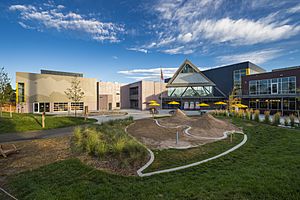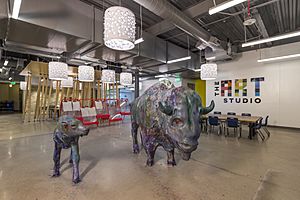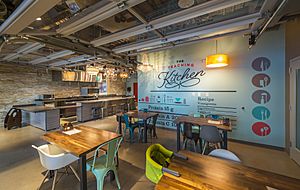Children's Museum of Denver facts for kids
 |
|
| Established | 1973 |
|---|---|
| Location | 2121 Children's Museum Drive, Denver, CO 80211 |
| Type | Children's museum |
The Children's Museum of Denver at Marsico Campus is a super fun place located in downtown Denver, Colorado. It's a big museum with lots of space, over 20 exciting exhibits, and welcomes around 450,000 visitors every year! This museum is specially designed for young kids, from babies up to eight years old, and their families. It's all about learning through play!
They focus on important subjects like Science, Technology, Engineering, and Math (STEM). They also teach about staying healthy, important skills for the future, reading, and art. The museum is part of a group called the Association of Children’s Museums. Their main goal is to create amazing experiences that celebrate how wonderful and joyful childhood can be.
Contents
A Look Back: The Museum's Story
The Children's Museum of Denver started in a traveling bus in June 1973. Imagine a museum on wheels! In 1975, it found a home in a renovated building on Bannock Street. Then, in 1984, it moved to its current spot along the South Platte River.
In 2014, the museum began a big expansion project. After two years of construction, the museum nearly doubled in size! This added 8 new exhibits, with one outside and seven inside. The museum stayed open during this time. It had its grand reopening on November 20, 2015, and was renamed the Children’s Museum of Denver at Marsico Campus. In 2015, it was even named one of the top 25 children's museums in the United States!
How the Museum Works
The Children’s Museum of Denver at Marsico Campus is a special kind of organization. It's a non-profit, which means it doesn't aim to make money for owners. Instead, any money it earns goes back into making the museum better.
The museum gets about 40% of its money from donations, grants, and sponsorships. The other 60% comes from things like ticket sales and memberships. A group of advisors, called a board of directors, helps guide the museum. A team of leaders, including the President and CEO, manages the daily operations. Over 80 people work at the museum, and hundreds of volunteers also help out every year!
Making the Museum Welcoming for Everyone
The museum works hard to make sure all visitors feel welcome. They have special ways to help children with disabilities and their families. For example, they offer specific times when the museum is quieter. During these times, fewer people are allowed in, and exhibit lights and sounds are turned down. This creates a calm environment for everyone.
Free Programs for Schools
The museum has a "Sponsored Admissions and Memberships Program." This program helps childcare centers and elementary schools. If 50% or more of their students qualify for the National School Lunch Program, they can get free educational programs. These programs are led by museum educators. Plus, the children who participate get a free year-long family membership! In 2015, about 15,000 students received free admission through this program.
Lower Admission for Families
Since January 2015, the museum has offered a special program for families receiving Supplemental Nutrition Assistance Program (SNAP) benefits. These families can visit the museum for just $1 per person. By December 2015, over 17,000 guests had used this program.
Growing Scientists Collaborative
This program helps young elementary school students from low-income families learn about science. It's a partnership with the Denver Botanic Gardens and Butterfly Pavilion. The program includes training for teachers, help with school lessons, and special visits to schools. It also offers field trips, science supplies, and free yearly passes to these fun learning places. This program started in 2003 and has even won an award for environmental education!
How Kids Learn at the Museum
The museum's exhibits are designed based on how children naturally learn. Experts like Jean Piaget and Lev Vygotsky studied how kids learn. They found that children learn best by doing things themselves. They explore, experiment, and play to understand the world around them. Learning isn't just about listening; it's about actively trying things out!
Because of this, the museum's exhibits allow for "open-ended play." This means kids can explore and use the exhibits in many different ways. The museum also knows that parents and caregivers are very important in a child's learning journey. So, the exhibit spaces are designed to encourage adults to play and learn alongside the children.
Exciting Permanent Exhibits
The museum has many amazing exhibits that focus on STEM, Health and Wellness, 21st Century Skills, Literacy, and the Arts.
- Altitude is a huge, three-and-a-half-story climbing structure inside the museum. It even has a real mountain gondola from Keystone, Colorado, and a wobbly monkey bridge! For younger kids, there's a smaller climbing area called Box Canyon at the bottom.
- The Art Studio is a place where you can get creative! You can work with clay, paint, and other materials. The studio also hosts four different artists each year who come to share their skills.
- Assembly Plant lets you be a builder! It has real tools and workbenches. You can put together projects using recycled materials donated by the community. There are even blueprints to give you ideas for what to build.
- Bubbles is all about making bubbles! You can use different devices to create bubbles of all sizes. This exhibit helps you learn about how water evaporates and turns into vapor.
- Center for the Young Child is a special area just for children three years old and younger. It also has "The Nest," a quiet studio with fewer bright lights and loud sounds.
- Energy explores different ways we get energy, like wind, solar power, and fossil fuels. You can try out a solar energy station, launch a hot air balloon, send off a rocket, and even use an air cannon!
- Fire Station No. 1 features a real, retired fire truck! You can also pretend to be a 911 dispatcher in the call center.
- Joy Park: An Outdoor Adventure is a huge outdoor play area, covering 30,000 square feet! It has many different activity spaces designed with Denver Parks and Recreation.
- Kinetics! is a physics exhibit where you can learn about motion and energy. It has a system of tubes and balls that show how things move.
- My Market is like a mini fresh produce market and kitchen. It teaches you about local food and how food gets from the farm to your table.
- The Teaching Kitchen offers daily programs where you can learn to make healthy food recipes.
- Water is a large exhibit, over 2,200 square feet, that lets you explore how an urban water system works through fun activities.




